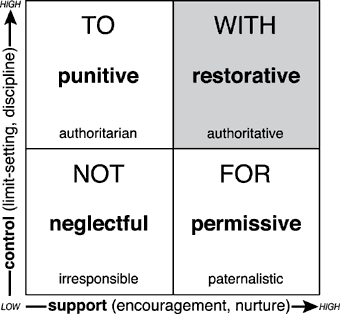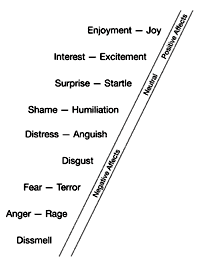Paper by IIRP president and founder Ted Wachtel, presented in a plenary session at "The Next Step: Developing Restorative Communities," the IIRP''s 7th International Conference on Conferencing, Circles and other Restorative Practices, in Manchester, England, UK, November 9-11, 2005.
Paper from ''The Next Step: Developing Restorative Communities'', the IIRP’s 7th
International Conference on Conferencing, Circles and other Restorative Practices,
9-11 November 2005, Manchester, England, UK.
|
|
Imagine a community where people regularly express their feelings to one another, including anger, in a safe and respectful way, and where conflict usually reaches quick resolution. Imagine a community where people routinely confront one another for their inappropriate behaviour and where wrongdoers are expected to reflect on what they have done, whom they have harmed and how they have harmed them, and then suggest how they can repair that harm. Imagine a community where people routinely run circle groups for themselves and their peers to help manage behaviour and even deal with chronic issues, like substance abuse. Imagine a community where managers earnestly solicit employees’ views in making decisions, explain decisions when they are made and clearly spell out their expectations. Imagine a community in which those in authority actively engage families and sometimes extended families in critical issues, such as setting goals for treatment or deciding where an abused young person should live or planning how to support a family member in maintaining sobriety. Imagine a community where people minimize gossip and try to deal with concerns and conflicts in an honest and direct fashion.
Using the kinds of restorative practices just described, the Community Service Foundation and Buxmont Academy, sister agencies of the International Institute for Restorative Practices, have endeavoured, albeit imperfectly, to establish such a community for their 250 employees and 500 adolescents who comprise the population of their eight schools, 16 group homes and other programs for delinquent and at-risk youth in southeastern Pennsylvania, USA. Evaluations of this restorative community show remarkable results: halving of criminal offending among participating youth and dramatic improvements in their self-esteem, social values and program completion rates. These gains are independent of referral source, age, gender, race, prior offending or other risk factors, but relate to the length of time spent in a restorative environment (McCold, 2002, 2004). The positive outcomes revealed by the evaluations of this small, specialized restorative community suggest that building restorative communities on a larger scale may be worthwhile.
So what would a restorative community look like? Restorative approaches vary. In social work, family group conferencing or family group decision making empowers extended families to meet privately, without professionals in the room, to make a plan to protect children in their own families from further violence and neglect (American Humane Association, 2003). In criminal justice, restorative circles and conferences allow victims, offenders and their respective family members and friends to come together to explore how everyone has been affected by an offence and, when possible, to decide how to repair the harm and meet their own needs (McCold, 2001). In education, circles and other restorative responses provide opportunities for students to play an active role in addressing wrongs and making things right (Riestenberg, 2002).
In characterizing these approaches, the terms also vary: practitioners in the criminal justice field use the term ‘restorative justice’ (Zehr, 1990); in social work they advocate ‘empowerment’ (Simon, 1992); in education they talk about ‘positive discipline’ (Nelsen, 1996) or ‘responsive classrooms’ (Charney, 1992); and in organizational leadership they use terms like ‘horizontal management’ (Denton, 1998). Yet all of these processes and phrases are related to a similar perspective about people, their needs and their motivation.
This perspective is emerging as a new social science that we call ‘restorative practices’ and define as ‘the science of restoring and developing social capital, social discipline, emotional well-being and civic participation through participatory learning and decision making’ (International Institute for Restorative Practices Mission Statement, 2005).
The International Institute for Restorative Practices (IIRP) has attempted to find or develop definitions and applicable theory to create an intellectual framework for this new field of study.
The Social Discipline Window (Figure 1) is a simple but useful element of that intellectual framework. It describes four basic approaches to creating and maintaining social norms and behavioural boundaries. The four are represented as different combinations of high or low control and high or low support. The restorative domain combines both high control and high support and is characterized by doing things with people, rather than to them or for them (Wachtel & McCold, 2000).

Figure 1. Social Discipline Window
The fundamental unifying hypothesis of restorative practices is that human beings are happier, more productive and cooperative, and more likely to make positive changes in their behaviour when those in positions of authority do things with them, rather than to them or for them. This hypothesis maintains that the punitive and authoritarian to mode and the permissive and paternalistic for mode are not as effective as the restorative, participatory, engaging with mode.
Restorative practices are not limited to formal processes, such as restorative and family group conferences or family group decision making, but range from informal to formal. On a Restorative Practices Continuum (Figure 2), the informal practices include affective statements that communicate people’s feelings, as well as affective questions that cause people to reflect on how their behaviour has affected others. Impromptu restorative conferences, groups and circles are somewhat more structured but do not require the elaborate preparation needed for formal conferences. Moving from left to right on the continuum, as restorative practices become more formal, they involve more people, require more planning and time, and are more structured and complete. Although a formal restorative process might have dramatic impact, informal practices have a cumulative impact because they are part of everyday life (Wachtel & McCold, 2000).

Figure 2. Restorative Practices Continuum
Because restorative practices foster the expression of affect or emotion, they also foster emotional bonds. The late Silvan S. Tomkins’s writings about psychology of affect (Tomkins, 1962, 1963, 1991) assert that human relationships are best and healthiest when there is free expression of affect—minimizing the negative, maximizing the positive, but allowing for free expression. Donald Nathanson, director of the Silvan S. Tomkins Institute, adds that it is through the mutual exchange of expressed affect that we build community, creating the emotional bonds that tie us all together (Nathanson, 1998). Restorative practices such as circles and conferences provide a safe environment for people to express and exchange intense emotion.
Tomkins identified nine distinct affects (Figure 3) to explain the expression of emotion in all human beings. Most of the affects are defined by pairs of words that represent the least and the most intense expression of a particular affect. The six negative affects are anger-rage, fear-terror, distress-anguish, disgust, dissmell (a word Tomkins coined to describe ‘turning up one’s nose’ at someone or something in a rejecting way) and shame-humiliation. Surprise-startle is the neutral affect, which functions like a reset button. The two positive affects are interest-excitement and enjoyment-joy.

Figure 3. The Nine Affects
(adapted from Nathanson, 1992)
Shame is worthy of special attention. Nathanson explains that shame is a critical regulator of human social behaviour. Tomkins defined shame as occurring any time that our experience of the positive affects is interrupted (Tomkins, 1987). So an individual does not have to do something wrong to feel shame. The individual just has to experience something that interrupts interest-excitement or enjoyment-joy (Nathanson, 1997). This understanding of shame provides a critical explanation for why victims of crime often feel a strong sense of shame, even though the offender committed the ‘shameful’ act.
Nathanson (1992, p. 132) has developed the Compass of Shame (Figure 4) to illustrate the various ways that human beings react when they feel shame. The four poles of the Compass of Shame and behaviours associated with them are:
- Withdrawal—isolating oneself, running and hiding
- Attack self—self put-down, masochism
- Avoidance—denial, abusing drugs, distraction through thrill seeking
- Attack others—turning the tables, lashing out verbally or physically, blaming others

Figure 4. The Compass of Shame
(adapted from Nathanson, 1992)
Nathanson says that the ‘attack others’ response to shame is responsible for the proliferation of violence in modern life. Usually people who have adequate self-esteem readily move beyond their feelings of shame. Nonetheless we all react to shame, in varying degrees, in the ways described by the compass. Restorative practices, by their very nature, provide an opportunity for us to express our shame, along with other emotions, and in doing so reduce their intensity. In restorative conferences, for example, people routinely move from negative affects through the neutral affect to positive affects.
Because the restorative concept has its roots in the field of criminal justice, we may erroneously assume that restorative practices are reactive, only to be used as a response to crime and wrongdoing. However, the free expression of emotion inherent in restorative practices not only restores, but also proactively builds new relationships and social capital. Social capital is defined as the connections among individuals (Putnam, 2001) and the trust, mutual understanding, shared values and behaviours that bind us together and make cooperative action possible (Cohen & Prusak, 2001). For example, primary schools and, more recently, some secondary schools use circles to provide students with opportunities to share their feelings, ideas and experiences, in order to establish relationships and social norms on a non-crisis basis. Businesses and other organizations utilize team-building circles or groups, in which employees are afforded opportunities to get to know each other better, similar to the processes used with students.
When authorities do things with people, whether reactively, to deal with crisis, or proactively, in the normal course of school or business, the results are almost always better (Wachtel & McCold, 2003). This fundamental thesis was evident in a Harvard Business Review article about the concept of ‘fair process’ in organizations (Kim & Mauborgne, 1997). The central idea of fair process is that ‘…individuals are most likely to trust and cooperate freely with systems—whether they themselves win or lose by those systems—when fair process is observed.’
The three principles of fair process are:
- Engagement—involving individuals in decisions that affect them by listening to their views and genuinely taking their opinions into account
- Explanation—explaining the reasoning behind a decision to everyone who has been involved or who is affected by it
- Expectation clarity—making sure that everyone clearly understands a decision and what is expected of them in the future
Fair process applies the restorative with domain of the Social Discipline Window to all organizations in all disciplines and professions (O’Connell, 2003; Costello & O’Connell, 2003; Schnell, 2003). As restorative approaches gain wider acceptance around the globe (Van Ness, 2005), we at the IIRP point to the potential for an international restorative social movement. John Braithwaite and his colleagues have described our vision as extending beyond restorative justice: ‘This means teaching children in schools how to confront any kind of wrongdoing or conflict restoratively; teaching parents how to raise children restoratively; teaching teachers how to teach restoratively; bosses how to manage restoratively; presidents how to be Nelson Mandelas’ (Ahmed, Harris, Braithwaite & Braithwaite, 2001, p. 61).
Having developed a variety of restorative approaches and an intellectual framework for explaining them, the next step in a restorative social movement is at a grassroots level, to develop restorative practices on a community-wide basis for our children and our families. The United Kingdom, where this international conference is being held, is fertile ground for building restorative communities. In various areas of this country, there is a convergence of restorative activity among multiple agencies—including schools, child welfare agencies, residential programs, police, youth offending teams and other elements of the social and criminal justice systems. We hope that the activities in the next three days of this conference will further raise our collective consciousness and inspire us to link together our local endeavours so as to enhance the effectiveness of restorative practices in our own communities and in our daily lives.
Our vision for the future is not a utopian fairy tale about a world where there is no conflict. We fully recognize that conflict is inherent and ongoing in human beings. Nor does the emerging field of restorative practices offer a prescription for suppressing our emotions and hiding our anger. Rather, restorative practices provides a practical way for us to express emotion freely but safely. Nor does restorative practices usurp the power of leaders and make decisions by committee. Rather, restorative practices offers a realistic way for all those in positions of authority to maximize support for their decisions and for social norms and behavioural boundaries.
We are concerned that humanity has developed its science and technology faster than its social skills. In light of the awesome and sometimes frightening powers within our grasp, we have an urgent need for better ways to manage our relationships and our decision making. Restorative practices, as an emerging field, offers that potential and may gradually become a primary modality for building relationships and social capital, for implementing decisions, and for responding to conflict and wrongdoing.
References
American Humane Association (2003). FGDM research and evaluation. Protecting Children, 18(1-2): whole volume.
Ahmed, E., Harris, N., Braithwaite, J., & Braithwaite, B. (2001). Shame management through reintegration (pp. 61-62). Cambridge, UK: Cambridge University Press.
Cohen, D., & Prusak, L. (2001). In good comp any: How social capital makes organizations work. Boston, MA: Harvard Business School Press.
Costello, B., & O’Connell, T. (2002, August). Restorative practices in the workplace. Paper presented at the Third International Conference on Conferencing, Circles and other Restorative Practices, Minneapolis, MN.
Denton, D. (1998). Horizontal management. Lanham, MD: Rowman & Littlefield.
International Institute for Restorative Practices Mission Statement (2005).
Kim, W., & Mauborgne, R. (1997). Fair process. Harvard Business Review, January 1.
McCold, P. (2004, November). Evaluation of a restorative milieu: Replication and extension for 2001-2003 discharges. Paper presented at the annual meeting of the American Society of Criminology, Nashville, TN. View here.
McCold, P. (2002, November). Evaluation of a restorative milieu: CSF Buxmont School/Day Treatment programs 1999-2001 evaluation outcome technical report. Paper presented at the American Society of Criminology Annual Meeting, Chicago, Illinois. View here.
McCold, P. (2001). Primary restorative justice practices. In G. Maxwell & A. Morris (Eds.), Restorative justice for juveniles (pp. 41-58). Oxford: Hart Publishing.
McCold, P., & Wachtel, T. (2003, August). In pursuit of paradigm: A theory of restorative justice. Paper presented at the XIII World Congress of Criminology, Rio de Janeiro, Brazil. https://www.iirp.edu/images/pdf/paradigm.pdf.
Wachtel, T., & McCold, P. (2000). Restorative justice in everyday life. In J. Braithwaite and H. Strang (Eds.), Restorative justice in civil society (pp. 117-125). New York: Cambridge University Press.
Nathanson, D. (1992). Shame and pride: Affect, sex, and the birth of the self. New York: Norton.
Nathanson, D. (1997). Affect theory and the compass of shame. In M. Lansky & A. Morrison (Eds.), The widening scope of shame. Hillsdale, NJ: The Analytic Press.
Nathanson, D. (1998, August). From empathy to community. Paper presented to the First North American Conference on Conferencing, Minneapolis, MN. View here.
O’Connell, T. (2002, August). Restorative practices for institutional discipline, complaints and grievance systems. Paper presented at the Third International Conference on Conferencing, Circles and other Restorative Practices, Minneapolis, MN.
Riestenberg, N. (2002, August). Restorative measures in schools: Evaluation results. Paper presented at the Third International Conference on Conferencing, Circles and other Restorative Practices, Minneapolis, MN.
Schnell, P. (2002, August). Toward a restorative leadership. Paper presented at the Third International Conference on Conferencing, Circles and other Restorative Practices, Minneapolis, MN.
Simon, B. (1994). The Empowerment Tradition in American Social Work. New York: Columbia University Press.
Tomkins, S. (1962). Affect imagery consciousness, Vol. I. New York: Springer.
Tomkins, S. (1963). Affect imagery consciousness, Vol. II. New York: Springer.
Tomkins, S. (1987). Shame. In D.L. Nathanson (Ed.). The many faces of shame (pp.133-161). New York: Norton.
Tomkins, S. (1991). Affect imagery consciousness, Vol. III. New York: Springer.
Van Ness, D. (2005, April). An overview of restorative justice around the world. Paper presented at Workshop 2: Enhancing criminal justice reform including restorative justice, Eleventh United Nations Congress on Crime Prevention and Criminal Justice, Bangkok, Thailand.

